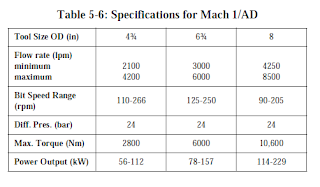Turbine Characteristics
• Torque and RPM are inversely proportional (i.e. as RPM increases,
torque decreases and vice versa).
• RPM is directly proportional to flow rate (at a constant torque).
• Torque is a function of flow rate, mud density, blade angle and the
number of stages, and varies if weight-on-bit varies.
• Optimum power output takes place when thrust bearings are balanced.
• Changing the flow rate causes the characteristic curve to shift.
• Off bottom, the turbine RPM will reach “run away speed” and torque
is zero.
• On bottom, and just at stall, the turbine achieves maximum torque and
RPM is zero.
• Optimum performance is at half the stall torque and at half the
runaway speed, the turbine then achieves maximum horsepower.
• A stabilized turbine used in tangent sections will normally cause the
hole to “walk” to the left.
• Torque and RPM are inversely proportional (i.e. as RPM increases,
torque decreases and vice versa).
• RPM is directly proportional to flow rate (at a constant torque).
• Torque is a function of flow rate, mud density, blade angle and the
number of stages, and varies if weight-on-bit varies.
• Optimum power output takes place when thrust bearings are balanced.
• Changing the flow rate causes the characteristic curve to shift.
• Off bottom, the turbine RPM will reach “run away speed” and torque
is zero.
• On bottom, and just at stall, the turbine achieves maximum torque and
RPM is zero.
• Optimum performance is at half the stall torque and at half the
runaway speed, the turbine then achieves maximum horsepower.
• A stabilized turbine used in tangent sections will normally cause the
hole to “walk” to the left.
